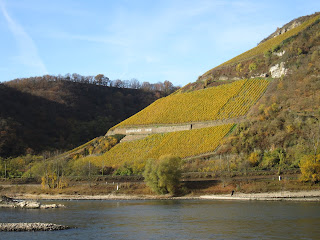As our boat left behind the picturesque castles, small towns, vineyards, and red sandstone of the southern Rhine, we came upon the largest city on our journey north, Cologne, and river landscape that became more urban and was often hidden by nightfall. Like a secret worth keeping, our boat cruised past what I would like to imagine as an industrial wasteland, fit for the filming a post-apacalyptical odyssey but not for the Viking Sun's illustrious guests' eyes.
As one of the oldest cities in Germany, Cologne, finds itself in a bit of a bind because of its near total destruction in World War II as well as its current economic importance which have erased its past nearly completely. Of course there are remnants of its past such as the cathedral, rebuilt facades, and chocolate museums, but the city contains very little "historical", or even anachronistic charm, except for the cathedral. Cologne is the largest city in the Rhein-Ruhr metropolitan area, one of the largest concentrations of human population in Europe, and therefore highly cosmopolitan, which is great because I was able to find Starbucks and Louis Vuitton, traveling essentials I generally was forced to make due without in much smaller places.
To explore the city a bit, here is the map:
View Cologne, Germany in a larger map
I did not go on the guided tour which walked from the boat to the cathedral and back, ignoring 99% of the rest of the city, I was looking for a Laundromat and internet.
I found some people walking across a skybridge. I'm not sure what a group so large was doing crossing a skybridge on a sunday, perhaps a sad chore of sorts.
Inspired by the skybridge walkers (skywalkers) I took a flight into the sky and through time to see the Viking Sun on its way out of Cologne under a bright sun and blue skies.
In the afternoon, having resigned myself to my weary fate of wearing unwashed clothes for a while longer, Mom and I went to the chocolate museum for obvious reasons.
The private museum was a poorly constructed PR machine, built by chocolate corporations such as Lindt and Ritter, and was capable of loosely presenting a brief history of chocolate production and consumption, masking the current living conditions of chocolate cultivators, having a small room dedicated to the plant's biology, and containing an installment which simulates a chocolate factory but is really just cooling and wrapping melted chocolate to give to greedy paws (like mine).
The museum went so far as to be offensive at times, such as this instance:
*
Mohrenkopf can be translated as Saracen's Head or Moor's Head and
Negerkuss is a chocolate covered marshmallow candy that can be translated as Negro Kiss
In a few words the text has attempted to justify colonialism while supplicating readers, with chocolate dreams, to put inequality, enslavement and exploitation in a distant past, erasing the present misery chocolate production and distribution causes.
Not wishing to end this post on an aura of this sort, I invite you peruse the Cologne Wikipedia articles:
Cologne
Cologne Cathedral






















































